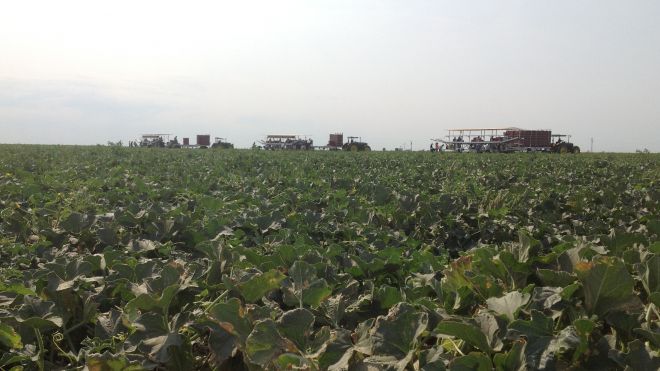As drought conditions and extreme heat continue to plague California, farmers in the Central Valley are struggling to get enough water to feed their land -- the bread basket of the Golden State.
But the weather alone isn’t to blame. Fish and Wildlife regulations tightly control water resources in the state, making it impossible earlier this year for the reservoirs to capture the rain, when it fell late last fall. And because of the endangered species in the region, pumping water is also restricted, leaving farmers high and dry.
“We had a dry winter and spring, and we lost the opportunity in autumn to capture the water, so it’s been worsened,” says Dave Kranz, a spokesman for the California Farm Bureau Federation.
He adds, “Farmers are only able to buy 20% of the water available to them in their contracts with the Central Valley Project [which controls the water resources]. And unless there’s a wet winter coming up, they might get 0% next year.”
For farmers, this will mean leaving even more fields fallow, leaving out some key crops altogether. Seasonal workers traveling to the Central Valley to pick crops will be turned away. And consumers will get hit where it hurts – at the register.
U.S. Bread Basket Goes Hungry
Pete Lucero at the Central Valley Project says the 20% water allocation will deliver water to 400,000 acres of land. To make up the deficit and ensure crops don’t die, farmers have to purchase water on the market, which is extremely expensive, given the drought and the heat
“The heat puts an additional strain, because it creates depletion and evaporation. It dries out the land, which isn’t getting natural irrigation,” says Lucero.
Vernon Crowder, senior vice-president and senior analyst in the food and agribusiness group at Rabobank, says water in the water market costs $450 per square acre foot during the last drought in 2009.
“Now, it’s being sold for more than $1,000,” says Crowder.
While some farmers are trying to supplement their water supplies with well water, Crowder says the saltiness of the well water can hurt crops. “You can irrigate pistachios with it, but almonds are more sensitive to salt. Some farmers are trying to use a blend, but it will do damage to the almond trees,” says Crowder. California is the only place in North America where almonds are grown commercially, and the Almond Board of California says the industry is worth $3.8 billion annually.
Because almond and other trees are a major investment for farmers, Central Valley growers are diverting water resources away from so-called “row crops” toward the trees. Crowder says farmers are most concerned with protecting the trees, because they’re often viewed as the primary support if the farm has taken out a land loan.
“We saw less row crops this year, and we’ll see even less next year,” says Crowder, who adds that the trend has increased over the past two decades. And with the Central Valley Project estimating that water allocation could be at 0% next year, farmers need to make tough choices now about which crops to plant, and which acres to leave fallow.
Farmers Concerned About the Future
Dan Errotabare, a small farmer in western Fresno County, is spending more than $1.5 million on water this summer – and fallowing 600 acres on his 3,000-acre farm.
“We’re in real trouble. It will probably mean most of the profits, and we’ll have to be pretty defensive just to get through the year,” he says. Errotabare grows almonds, pistachios, wine grapes, garlic, tomatoes and more on Errotabare Farms.
At Harris Farms, which has cattle and produce operations in the San Joaquin Valley, EVP William Bourdeau says they’ll have to fallow 66% of the farm’s nearly 14,000 acres if the 0% water allocation occurs.
“It’s going to be very difficult, because we employ lots of people. They’re hard-working and they want to work, but we won’t be able to provide them with jobs,” says Bourdeau.
He estimates that Harris Farms will be able to hire only 500-1,000 of the nearly 4,000 seasonal workers employed by the farm in a good year. This year, he says Harris Farms isn’t growing peppers, broccoli, cotton, cantaloupe and watermelons, in order to preserve the permanent almond, pistachio and asparagus crops.
Both Errotabare and Bourdeau stress that their problems are manmade, due to government intervention – not the product of the drought alone.
